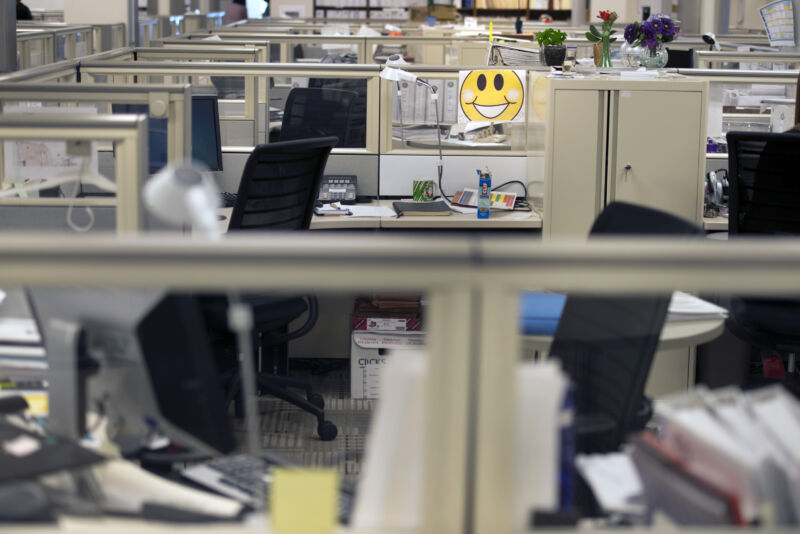RTO doesn’t improve company value, but does make employees miserable: Study
WFH FTW —
Data is consistent with bosses using RTO to reassert control and scapegoat workers.

Enlarge / Empty cubicles
For some, having to work from home during the COVID-19 pandemic was stressful. Parents balanced job duties while caring for children. Some struggled to set up a home office and adjust to new tools, like video conferencing. Lonely workdays at home added to social isolation. The line between work and life blurred.
For others, working from home was a boon—comfort, convenience, flexibility, no commuting or rush-hour traffic, no office-environment distractions. When the acute aspects of the pandemic receded, some who at first struggled began to settle into a work-from-home (WFH) groove and appreciated the newfound flexibility.
Then, bosses began calling their employees back to the office. Many made the argument that the return-to-office (RTO) policies and mandates were better for their companies; workers are more productive at the office, and face-to-face interactions promote collaboration, many suggested. But there’s little data to support that argument. Pandemic-era productivity is tricky to interpret, given that the crisis disrupted every aspect of life. Research from before the pandemic generally suggested remote work improves worker performance—though it often included workers who volunteered to WFH, potentially biasing the finding.
For a clearer look at the effect of RTO policies after the pandemic, two business researchers at the University of Pittsburgh examined a sample of firms on the S&P 500 list—137 of which had RTO mandates and 320 that clearly did not between June 2019 and January 2023. The researchers collected publicly available data on each company, including financial data and employee reviews. They then looked at what factors were linked to whether a firm implemented an RTO policy—such as the company’s size, financial constraints, and CEO characteristics—as well as the consequences of the RTO mandates—employee satisfaction and financial metrics of the firms.
Overall, the analysis, released as a pre-print, found that RTO mandates did not improve a firm’s financial metrics, but they did decrease employee satisfaction.
Drilling down, the data indicated that RTO mandates were linked to firms with male CEOs who had greater power in the company. Here, power is measured as the CEO’s total compensation divided by the average total compensation paid to the four highest-paid executives in the firm.
Before the analysis, the researchers hypothesized that RTO mandates may be used to blame employees for poor firm performance. But, companies that have institutional ownership—such as hedge funds or endowments—would not fall for such a “blame game” and would thus would be less likely to implement an RTO mandate. The data supported those hypotheses. Firms with weaker stock performance before employees were able to return to the office were more likely to enforce RTO mandates. However, institutional ownership decreased the probability of RTO mandates.
Although CEOs often justified RTO mandates by arguing it will improve the company’s performance, “Results of our determinant analyses are consistent with managers using RTO mandates to reassert control over employees and blame employees as a scapegoat for bad firm performance,” the researchers concluded.
Unsurprisingly, the researchers also found that RTO mandates were linked to decreases in employee satisfaction. Specifically, after an RTO mandate, employees’ ratings significantly declined on overall job satisfaction, work-life balance, senior management, and corporate culture. But their ratings of factors unrelated to RTO did not change, indicating that the RTO mandate was driving dissatisfaction.
The study has limitations, including a short time frame to look at long-term outcomes of RTO policies and a time frame that overlapped with a labor shortage. Worker responses may be different in a tight labor market. Still, the study adds some data to the ongoing debate—and feuds—over RTO policies.
RTO doesn’t improve company value, but does make employees miserable: Study Read More »
